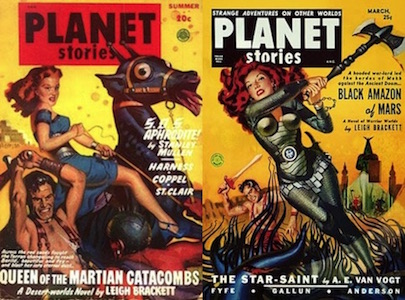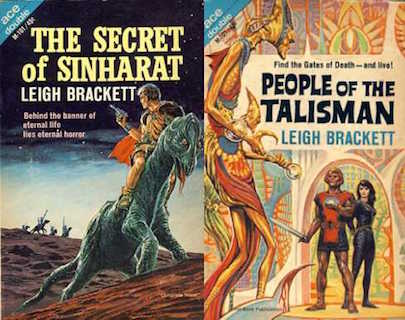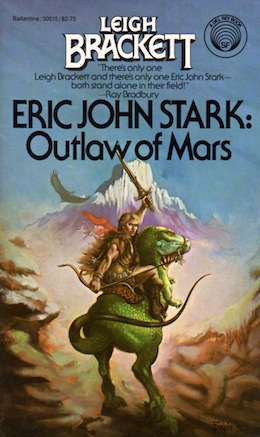In this monthly series reviewing classic science fiction books, Alan Brown looks at the front lines and frontiers of science fiction; books about soldiers and spacers, explorers and adventurers. Stories full of what Shakespeare used to refer to as “alarums and excursions”: battles, chases, clashes, and the stuff of excitement.
As the 20th Century unfolded, and explorers made their way to the furthest reaches of the Earth, it became increasingly clear that there were no lost civilizations or mysterious beasts lurking just around the corner. As a result, adventure stories that might have been set on the Earth in the past moved to the other planets of the Solar System, and the planetary romance genre was born. These tales were short on science, but long on adventure, battles, horror, and passion. One of the greatest practitioners in this genre was Leigh Brackett, and one of her greatest characters was the adventurer Eric John Stark.
Eric John Stark: Outlaw of Mars, which I encountered in the early 1980s, turned out not to be a novel, but consisted of two novellas, both of which first appeared as shorter tales in the magazine Planet Stories. They were then expanded, retitled, and appeared as front and back of an Ace Double in 1964. And finally, they were repackaged in 1982 under the title Eric John Stark: Outlaw of Mars. The stories were both set on a Mars full of dying cities and strange inhabitants. Their protagonist was an Earthman, but one with savage roots: an adventurer who had been raised by the aboriginal inhabitants of Mercury’s twilight region. Before we look at the tales themselves, however, it’s worth spending some time delving into where and how they first appeared. The magazine Planet Stories is not widely remembered these days, and the Ace Doubles, with their quirky format, are a rarity even in huckster rooms at SF conventions—but in their time, both were a big part of the science fiction field.
Planet Stories
 The magazine Planet Stories was published from 1939 to 1955. It specialized in stories known as planetary romances, tales that focused on the exotic setting of another world rather than on the science of getting there. The magazine never appeared in my house while I was growing, which is too bad, because from what I have seen, I would have enjoyed it. I suspect that my dad, who subscribed to Analog and Galaxy, liked a little more rigor in his science fiction; I also suspect that the lurid covers would not have met with my mother’s approval.
The magazine Planet Stories was published from 1939 to 1955. It specialized in stories known as planetary romances, tales that focused on the exotic setting of another world rather than on the science of getting there. The magazine never appeared in my house while I was growing, which is too bad, because from what I have seen, I would have enjoyed it. I suspect that my dad, who subscribed to Analog and Galaxy, liked a little more rigor in his science fiction; I also suspect that the lurid covers would not have met with my mother’s approval.
Back in those days, there were still hopes that we lived in a solar system teeming with life, and there seemed to be a rough consensus about what conditions would be like on other worlds. On Mercury, at that time thought to be tidally locked, there might be a thin twilight belt between the molten and frozen sides where life could exist. Under the clouds of Venus, all sorts of strange civilizations could lurk. Mars could still have remnants of ancient cities, linked by a web of canals. The outer planets could have their own strange ecological niches. And the writers of Planet Stories imagined quite a few strange adventures occurring in those settings. Despite the lowbrow reputation of the magazine, work by many notable writers of the day, including Ray Bradbury, Isaac Asimov, and Phillip K. Dick, appeared in its pages. One of the most prolific contributors was Leigh Brackett, whose stories for the magazine included the luridly-titled “Queen of the Martian Catacombs” and “Black Amazon of Mars.”
Ace Doubles
 The Ace Doubles were an interesting adaptation—a reaction to readers’ changing habits. The pulp magazines had produced a significant body of work at shorter lengths, many in the novelette/novella range, while the increasingly popular paperback books were in a format that lent itself to longer works. The solution Ace came up with was to print books in a format called “tête-bêche,” putting two shorter works back to back; books that had two front covers, kind of a literary version of a Möbius strip. The covers were printed upside down from each other, so no matter which cover you started from, the spine was still on the left side. This gave booksellers two choices for displaying the book; if one cover didn’t generate sales, they could flip it and present the second cover instead. The format was successful enough that over 200 books were printed in this format from 1952 to 1973; the series then continued until 1978, with two works in a book, but without the distinctive double cover format. The format was briefly revived by Tor Books with their Tor Double Novels from 1988 to 1991.
The Ace Doubles were an interesting adaptation—a reaction to readers’ changing habits. The pulp magazines had produced a significant body of work at shorter lengths, many in the novelette/novella range, while the increasingly popular paperback books were in a format that lent itself to longer works. The solution Ace came up with was to print books in a format called “tête-bêche,” putting two shorter works back to back; books that had two front covers, kind of a literary version of a Möbius strip. The covers were printed upside down from each other, so no matter which cover you started from, the spine was still on the left side. This gave booksellers two choices for displaying the book; if one cover didn’t generate sales, they could flip it and present the second cover instead. The format was successful enough that over 200 books were printed in this format from 1952 to 1973; the series then continued until 1978, with two works in a book, but without the distinctive double cover format. The format was briefly revived by Tor Books with their Tor Double Novels from 1988 to 1991.
In 1964, for their publication as an Ace Double, Leigh Brackett (possibly with the assistance of her husband Edmund Hamilton), expanded the story “Queen of the Martian Catacombs” into “The Secret of Sinharat,” and expanded “Black Amazon of Mars” into “People of the Talisman.”
About the Author

Leigh Brackett (1915-1978) was a major voice in science fiction, but in the opinion of many, does not get the attention she deserves. The stories she chose to write were of the planetary romance and space opera varieties, sub-genres that did not get a lot of respect for many years. Her husband, Edmund Hamilton, a prolific author of space opera himself (including the adventures of Captain Future), has suffered a similar fate. Critics and historians of science fiction have traditionally tended to favor harder science fiction, and writers who did not care to fit their tales into John Campbell’s house style at Analog magazine were often looked down upon. Measuring planetary romance and space opera by the standards of Analog, however, is like criticizing a dolphin for not being able to run a footrace. Brackett’s stories, regardless of their setting, are compelling and full of mystery, suspense, and adventure. The prose is crisp and evocative, and the characters are interesting and unpredictable.
The genre was not friendly to female authors in the post-WWII era, but Brackett’s gender-ambiguous first name allowed her to write under her own name. In many ways, her writing is not drastically different from the male writers of her era, except for her female characters, who have more of what was back then called “moxie,” but now gets referred to as “agency.” These women do not just exist to be love interests, and when faced with danger would come out swinging, not simply waiting to be rescued. Brackett also wrote in other genres, such as mystery, and this led to a career in film writing. She was generous with other authors, and Ray Bradbury gave her a lot of credit for helping him develop his skills.
Her mystery writing gained her the attention of noted director Howard Hawks, who needed help on a script for The Big Sleep and reportedly asked someone to contact the “guy” named Brackett who had written No Good from a Corpse. She ended up sharing scriptwriting credit for that film with William Faulkner and Jules Furthman. She scripted several western adventure pictures for Hawks that starred John Wayne, and worked on other film and TV projects. It’s interesting to wonder what science fiction she would have produced during this years, had she not been working on film and TV projects.
Brackett’s most memorable creation was the adventurer Eric John Stark, a compelling and morally ambiguous character whose most notable adventures were set on Mars, and appeared in Planet Stories. In the 1970s, she returned to the character with a trilogy set on the exoplanet Skaith. Her most noted “serious” science fiction novel was The Long Tomorrow, a tale set in a post-apocalyptic America.
In the 1970s, one of Brackett’s science fiction books caught the attention of another Hollywood director, George Lucas, who contacted her to write the first draft of the script for the movie that came to be called The Empire Strikes Back. Apparently, when he contacted her, he had not yet connected her name with the person who had already done so much work in film. She died shortly after submitting her first draft, and while the final script was quite different, she is credited for developing many of the themes and scenes that ended up in the final film. This brought renewed interest in her work, and led to reprints of many of her works in the years after the film appeared.
Brackett had a fascinating life, and you can (as I did while writing this review) spend hours reading about her and her career on the internet—a good starting point is this article from io9 by Charlie Jane Anders, which is full of links to other sources.
Eric John Stark: Outlaw of Mars
The book Eric John Stark: Outlaw of Mars is pretty much the old Ace Double from 1964 printed in a traditional single cover format, with only the table of contents indicating that the volume contains two separate works. The volume does not have a very compelling cover, especially compared to those that appeared on the earlier incarnations of the tales. I bought it because I recognized Brackett’s name from the Skaith books, and from her work on The Empire Strikes Back.
“The Secret of Sinharat” opens with Stark losing ground to a group of pursuers as his mount fails. Stark has been summoned by a troublemaker named Delgaun of Valkis for a mercenary job, but it now appears he will not finish the journey. The pursuers, however, are led by interplanetary policeman Simon Ashton, the man who rescued Stark when the aboriginal tribe that raised him was murdered. Since then, Simon has been the closest thing Stark has had to a father. Ashton offers him a deal: Delgaun plans to upset the political order on Mars to plunder the cities and set himself up as ruler. Stark is facing charges and jail time, but Ashton offers him clemency if he disrupts Delgaun’s efforts. Had it been anyone else asking, I suspect that Stark would have refused. But he agrees, and heads on to join Delgaun and his followers.
Stark is introduced to Kynon, a man who claims to have rediscovered the ancient Martian device of the people known as Ramas—a device that can transfer a mind from an old person to a younger one. They “demonstrate” the device to their followers, but in private, Stark accuses them of being frauds, which they admit. Stark sees a mysterious woman, Berild, who is part of the cabal that is leading the uprising. Stark is sent to retrieve one of Delgaun’s minions from the local equivalent of an opium den, when he encounters Fianna, Berild’s attractive servant girl, who warns Stark that he is heading into a trap. The trap proves insufficient to defeat a man like Stark, however, and he returns with the minion slung over his shoulder.
The rebels head out in a caravan, and during a sandstorm Stark is again betrayed, and ends up stranded in the desert with Berild. They suffer greatly, but she shows an uncanny ability to navigate the lost cities they encounter. Stark starts to wonder if ancient legends might be true. After the treachery he has seen, he has no aversion to disrupting Delgaun’s plans, and soon all concerned will find that the ancient legends of Mars are not to be scorned, and that the old powers might still be stirring.
“The People of the Talisman” opens with a dying friend entrusting Stark with a talisman hidden in a belt buckle. The talisman reputedly can protect the city of Kushat by bringing a mysterious force through the ominously named Gates of Death. The dying man makes Stark promise to return it. Stark finds that holding the talisman opens his mind to unsettling images and voices. He is soon captured by an army led by the enigmatic Lord Ciaran, who always appears in full armor and enclosed helmet, carries a giant axe; the army is heading to attack Kushat. They torture Stark for information, but he breaks free, and after an epic battle where his savage nature comes to the fore, he makes his escape.
Stark arrives at Kushat to find a city in turmoil. The authorities are hiding the fact that the talisman is missing, although many in the city already suspect the truth. Stark is taken to well-meaning but ineffective military leaders, who ignore his warnings of an invading army. He doesn’t trust them enough to turn over the talisman, and they are considering jailing him when a woman called Thanis vouches for him, and offers to take him in. It turns out that she and her brother are friends to Stark’s late companion, and eventually he trusts them enough to reveal the talisman.
The attack comes just as Stark had warned, and there is a brutal battle for the city. Stark meets Lord Ciaran and during their combat, he knocks off the ever-present helmet to reveal a secret: Ciaran is a striking woman with flowing red hair. As that reveal is spoiled by the Planet Stories cover and title of “Black Amazon of Mars,” I suspect many reading this review have already figured that out. Stark and Ciaran are separated by the fighting, and soon Stark and his friends find that only the talisman can save the city. But the secrets lurking beyond the Gates of Death prove to be a danger to everyone, and soon enemies become allies in a desperate struggle for survival…
Final Thoughts
These two stories are fine examples of the planetary romance sub-genre; there is a sense of menace and mystery throughout. Brackett has a knack for writing characters and settings that feel real and well-rounded with very little description, giving readers just enough detail to bring them to life in their minds. The twists and turns of the narrative feel natural and unforced, but are also full of surprises. The battle scenes are exciting, and feel real and immediate. Stark is a grand character, and comes across as a force to be reckoned with: larger than life and morally complex, with a complicated and layered personality. You feel what he feels as you read the story, and experience the immediacy of his pain, fury, hunger, affection, and horror.
And now, as always, I turn the floor to you. If you’ve read the stories, I’d be interested in hearing your opinions—and also anything you might have to say about Leigh Brackett and her career in general.
Alan Brown has been a science fiction fan for five decades, especially fiction that deals with science, military matters, exploration and adventure. He is also a retired reserve officer with a background in military history and strategy.










